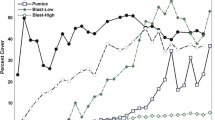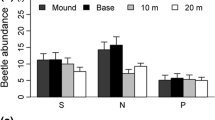Abstract
The effects of bannertail kangaroo rat (Dipodomys spectabilis) mounds and associated soil-surface disturbance on plant species composition and diversity in the Chihuahuan Desert were examined with multivariate analysis. Kangaroo rat mounds created disturbance gaps and contributed to local species diversity by creating microhabitats that supported unique plant communities. These microhabitats supported populations of species that were relatively rare in surrounding areas. The diversity observed at the whole habitat level resulted from (1) local spatial heterogeneity, because the mounds offered microenvironments with distinctive nutrient, water, and light conditions; and (2) local patterning of disturbance, because the digging and traffic of the kangaroo rats maintained high levels of soil disturbance at and near the mounds. At a finer scale, species diversity was highest in the area immediately adjacent to active and inactive mounds, and was lower on both the highly disturbed soil of the mounds and in the relatively undisturbed area between mounds. Lowest species diversity occurred on inactive mounds. Annual plant biomass was much greater on mounds than in inter-mound areas. The results support the predictions that intermediate levels of disturbance and small-scale environmental heterogeneity contribute to supporting high species diversity.
Similar content being viewed by others
References
Abugov R (1982) Species diversity and phasing of disturbance. Ecology 63:289–293
Agnew W, Uresk DW, Hansen RM (1986) Flora and fauna associated with prairie dog colonies and adjacent ungrazed mixed-grass prairie in western South Dakota. J Range Manage 39:135–139
Bazzaz FA (1990) Plant-plant interactions in successional environments. In: Grace JB, Tilman D (eds) Perspectives on plant competition. Academic Press, San Diego, pp 239–264
Best TL (1972) Mound development by a pioneer population of the banner-tailed kangaroo rat in eastern New Mexico. Am Midl Nat 87:201–206
Best TL, Intress C, Shull KD (1988) Mound structure in three taxa of Mexican kangaroo rats (Dipodomys spectabilis cratodon, D. s. zygomaticus and D. nelsoni). Am Midl Nat 119:216–220
Bowers MA, Brown JH (1992) Structure in a desert rodent community: use of space around Dipodomys spectabilis mounds. Oecologia 92:242–249
Bowers MA, Thompson DB, Brown JH (1987) Spatial organization of a desert rodent community: food addition and species removal. Oecologia 72:77–82
Brown JH, Harney BA (1993) Population and community ecology of heteromyid rodents in temperate habitats. In: Genoways HH, Brown JH (eds) Biology of the Heteromyidae (Special publication 10). Am. Soc. Mamm. Stillwater, Oklahoma, pp 618–651
Brown JH, Heske EJ (1990) Control of a desert-grassland transition by a keystone rodent guild. Science 250:1705–1707
Brown JH, Munger JC (1985) Experimental manipulation of a desert rodent community: food addition and species removal. Ecology 66:1545–1563
Brown JH, Davidson DW, Reichman OJ (1979) An experimental study of competition between seed-eating desert rodents and ants. Am Zool 19:1129–1143
Brown JH, Davidson DW, Munger JC, Inouye RS (1986) Experimental community ecology the desert granivore system. In: Diamond J, Case TJ (eds) Community ecology. Harper and Row, New York, pp 41–61
Brown VK (1992) Plant succession and life history strategy. Trends Ecol Evol 7:143–144
Cody ML (1975) Towards a theory of continental species diversity. In: Cody MI, Diamond J (eds) Ecology and evolution of communities. Harvard University Press, Cambridge, pp 214–257
Connell JH (1978) Diversity in tropical rain forests and coral reefs. Science 199:1302–1310
Davidson DW, Samson DA, Inouye RS (1985) Granivory in the Chihuahuan Desert: interactions within and between trophic levels. Ecology 66:486–502
Denslow JS (1980) Patterns of plant species diversity during succession under different disturbance regimes. Oecologia 46:18–21
Fenner M (1985) Seed ecology. Chapman and Hall, London
Frye RJ (1983) Experimental field evidence of interspecific aggression between two species of kangaroo rats (Dipodomys). Oecologia 59:74–78
Grant WE, French NR, Golse LJ Jr (1980) Effects of pocket gopher mounds on plant production in shortgrass prairie ecosystem. Southwest Nat 25:215–224
Greene RA, Reynard C (1932) The influence of two burrowing rodents, Dipodomys spectabilis spectabilis (kangaroo rat) and Neotoma albigula albigula (pack rat) on desert soils of Arizona. Ecology 13:73–80
Guo Q (1994) Dynamic desert plant community ecology: changes in space and time. PhD dissertation, University of New Mexico, Albuquerque
Guo Q, Thompson DB, Valone TJ, Brown JH (1995) The effects of vertebrate granivores and folivores on plant community structure in the Chihuahuan Desert. Oikos 73:251–259
Gutierrez JR, Whitford WG (1987) Responses of Chihuahuan Desert herbaceous annuals to rainfall augmentation. J Arid Environ 12:127–139
Hawkins LK, Nicoletto PF (1992) Kangaroo rat burrows structure the spatial organization of ground-dwelling animals in a semi arid grassland. J Arid Environ 20:199–208
Heske EJ, Brown JH, Guo Q (1993) The effects of kangaroo rat exclusion in the Chihuahuan Desert, southeastern Arizona: desert shifts toward grassland. Oecologia 95:520–524
Holdenreid R (1957) Natural history of the bannertail kangaroo rat in New Mexico. J Mammal 38:330–350
Horn HS (1975) Markovian processes of forest succession. In: Cody ML, Diamond J (eds) Ecology and evolution of communities. Harvard University Press, Cambridge, pp 196–211
Huntly N, Inouye RS (1988) Pocket gophers in ecosystems: patterns and mechanisms. Bioscience 38:786–793
Huston MA (1979) A general hypothesis of species diversity. Am Nat 113:81–101
Huston MA, Smith T (1987) Plant succession: life history and competition. Am Nat 130:168–198
Inouye RS (1991) Population biology of desert annual plants. In: Plois GA (ed) The ecology of desert communities. University of Arizona Press, Tucson, pp 27–54
Kalisz PJ, Stone EL (1984) Soil mixing by scarab beetles and pocket gophers in north-central florida. Soil Sci Soc Am J 48:169–172
Kay FR, Whitford WG (1978) The burrow environment of the banner-tailed kangaroo rat, Dipodomys spectabilis, in south-central New Mexico. Am Midl Nat 99:270–279
Laycock WA (1958) The initial pattern of revegetation of pocket gopher mounds. Ecology 39:346–351
MacArthur R, Recher H, Cody M (1966) On the relation between habitat selection and species diversity. Am Nat 100:319–332
Martin PS (1963) The last 10,000 years. University of Arizona Press, Tucson
McConnaughay KDM, Bazzaz FA (1987) The relationship between gap size and performance of several colonizing annuals. Ecology 68:411–416
Mielke HW (1977) Mound building by pocket gophers (Geomyidae): the impact on soils and vegetation in North America. J Biogeogr 4:171–180
Miller TE (1982) Community diversity and interactions between the size and frequency of disturbance. Am Nat 120:533–536
Monson G (1943) Food habits of the banner-tailed kangaroo rat in Arizona. J Wildlife Manage 7:98–102
Mooney HA, Godron M (1983) (eds) Disturbance and ecosystems. Springer, Berlin Heidelberg New York
Moorhead DL, Fisher FM, Whitford WG (1988) Cover of spring annuals on nitrogen-rich kangaroo rat mounds in a Chihuahuan Desert grassland. Am Midl Nat 120:443–447
Moroka NR, Beck F, Pieper RD (1982) Impact of burrowing activity of the bannertail kangaroo rat on southern New Mexico desert rangelands. J Range Manage 35:707–710
Mun HT, Whitford WG (1990) Factors affecting annual plants assemblages on banner-tailed kangaroo rat mounds. J Arid Environ 18:165–173
Paine RT, Vadas RL (1969) The effects of grazing by sea orchins, Strongylocentrotus spp., on benthic algal populations. Limnol Oceangr 14:710–719
Pickett STA, White PS (1985) (eds) The ecology of natural disturbance as patch dynamics. Academic Press, New York
Reichman OJ, Smith SC (1985) Impact of pocket gopher burrows on overlying vegetation. J Mammal 66:720–725
Rosenzweig ML, Winakur L (1969) Population ecology of desert rodent communities: habitats and environmental complexity. Ecology 50:558–572
Rydin H, Rorgeg†rd S (1991) Plant characteristics over a century of primary succession on islands: Lake Hj,,lmaren. Ecology 72:1089–1101
Salisbury E (1975) The survival value of modes of dispersal. Proc R Soc Lond B 188:183–188
Samson DA, Philippi TE, Davidson DW (1992) Granivory and competition as determinants of annual plant diversity in the Chihuahuan Desert. Oikos 65:61–80
SAS (1988) SAS/STAT User's guide, release 6.03 edn. SAS Institute, Cary
Schroder GD, Geluso KN (1975) Spatial distribution of Dipodomys spectabilis mounds. J Mammal 56:363–368
Sousa WP (1984) The role of disturbance in natural communities. Annu Rev Ecol Syst 15:353–391
Spencer SR, Cameron GN, Eshelman BD, Cooper LC, Williams LR (1985) Influence of pocket gopher mounds on a Texas coastal prairie. Oecologia 66:111–115
Turkington R, Aarssen LW (1984) Local-scale differentiation as a result of competitive interactions. In: Dirzo R, Sarukhan J (eds) Perspectives on plant population ecology. Sinauer, Sunderland, pp 107–127
Tilman D (1982) Resource competition and community structure. Princeton University Press, Princeton
Tilman D (1983) Plant succession and gopher disturbance along an experimental gradient. Oecologia 60:285–292
Tilman D (1988) Plant strategies and the dynamics and structure of plant communities (Monographs in population biology). Princeton University Press, Princeton
Van Andel J, Bakker JP, Grootjians AP (1993) Mechanisms of vegetation succession: a review of concepts and perspectives. Acta Bot Neerl 42:413–433
Vorhies CT, Taylor WP (1922) Life history of the kangaroo rat, Dipodomys spectabilis Merriam (Bulletin 1091). United States Department of Agriculture, Washington
Author information
Authors and Affiliations
Rights and permissions
About this article
Cite this article
Guo, Q. Effects of bannertail kangaroo rat mounds on small-scale plant community structure. Oecologia 106, 247–256 (1996). https://doi.org/10.1007/BF00328605
Received:
Issue Date:
DOI: https://doi.org/10.1007/BF00328605




